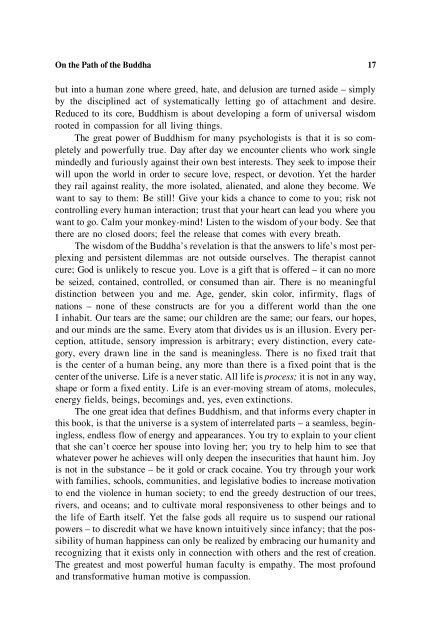Psychology & Buddhism.pdf
Psychology & Buddhism.pdf
Psychology & Buddhism.pdf
Create successful ePaper yourself
Turn your PDF publications into a flip-book with our unique Google optimized e-Paper software.
On the Path of the Buddha 17<br />
but into a human zone where greed, hate, and delusion are turned aside – simply<br />
by the disciplined act of systematically letting go of attachment and desire.<br />
Reduced to its core, <strong>Buddhism</strong> is about developing a form of universal wisdom<br />
rooted in compassion for all living things.<br />
The great power of <strong>Buddhism</strong> for many psychologists is that it is so completely<br />
and powerfully true. Day after day we encounter clients who work single<br />
mindedly and furiously against their own best interests. They seek to impose their<br />
will upon the world in order to secure love, respect, or devotion. Yet the harder<br />
they rail against reality, the more isolated, alienated, and alone they become. We<br />
want to say to them: Be still! Give your kids a chance to come to you; risk not<br />
controlling every human interaction; trust that your heart can lead you where you<br />
want to go. Calm your monkey-mind! Listen to the wisdom of your body. See that<br />
there are no closed doors; feel the release that comes with every breath.<br />
The wisdom of the Buddha’s revelation is that the answers to life’s most perplexing<br />
and persistent dilemmas are not outside ourselves. The therapist cannot<br />
cure; God is unlikely to rescue you. Love is a gift that is offered – it can no more<br />
be seized, contained, controlled, or consumed than air. There is no meaningful<br />
distinction between you and me. Age, gender, skin color, infirmity, flags of<br />
nations – none of these constructs are for you a different world than the one<br />
I inhabit. Our tears are the same; our children are the same; our fears, our hopes,<br />
and our minds are the same. Every atom that divides us is an illusion. Every perception,<br />
attitude, sensory impression is arbitrary; every distinction, every category,<br />
every drawn line in the sand is meaningless. There is no fixed trait that<br />
is the center of a human being, any more than there is a fixed point that is the<br />
center of the universe. Life is a never static. All life is process; it is not in any way,<br />
shape or form a fixed entity. Life is an ever-moving stream of atoms, molecules,<br />
energy fields, beings, becomings and, yes, even extinctions.<br />
The one great idea that defines <strong>Buddhism</strong>, and that informs every chapter in<br />
this book, is that the universe is a system of interrelated parts – a seamless, beginingless,<br />
endless flow of energy and appearances. You try to explain to your client<br />
that she can’t coerce her spouse into loving her; you try to help him to see that<br />
whatever power he achieves will only deepen the insecurities that haunt him. Joy<br />
is not in the substance – be it gold or crack cocaine. You try through your work<br />
with families, schools, communities, and legislative bodies to increase motivation<br />
to end the violence in human society; to end the greedy destruction of our trees,<br />
rivers, and oceans; and to cultivate moral responsiveness to other beings and to<br />
the life of Earth itself. Yet the false gods all require us to suspend our rational<br />
powers – to discredit what we have known intuitively since infancy; that the possibility<br />
of human happiness can only be realized by embracing our humanity and<br />
recognizing that it exists only in connection with others and the rest of creation.<br />
The greatest and most powerful human faculty is empathy. The most profound<br />
and transformative human motive is compassion.











